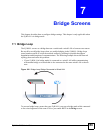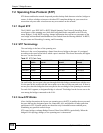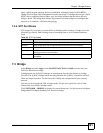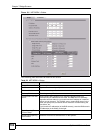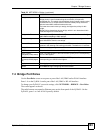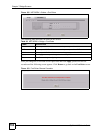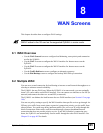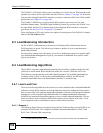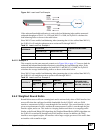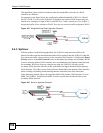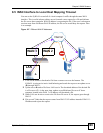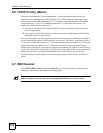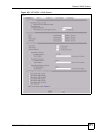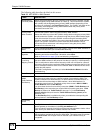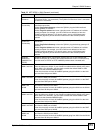
Chapter 8 WAN Screens
ZyWALL 2WG User’s Guide
166
The ZyWALL's NAT feature allows you to configure sets of rules for one WAN interface and
separate sets of rules for the other WAN interface. Refer to Chapter 17 on page 385 for details.
You can select through which WAN interface you want to send out traffic from UPnP-enabled
applications (see Chapter 23 on page 461).
The ZyWALL's DDNS lets you select which WAN interface you want to use for each
individual domain name. The DDNS high availability feature lets you have the ZyWALL use
the other WAN interface for a domain name if the configured WAN interface's connection
goes down. See Section 21.10.2 on page 437 for details.
When configuring a VPN rule, you have the option of selecting one of the ZyWALL's domain
names in the My Address field.
8.3 Load Balancing Introduction
On the ZyWALL, load balancing is the process of dividing traffic loads between the two
WAN interfaces (or ports). This allows you to improve quality of services and maximize
bandwidth utilization.
See also policy routing to provide quality of service by dedicating a route for a specific traffic
type and bandwidth management to specify a set amount of bandwidth for a specific traffic
type on an interface.
8.4 Load Balancing Algorithms
The ZyWALL uses three load balancing methods (least load first, weighted round robin and
spillover) to decide which WAN interface the traffic for a session
1
(from the LAN) uses.
The following sections describe each load balancing method. The available bandwidth you
configure on the ZyWALL refers to the actual bandwidth provided by the ISP and the
measured bandwidth refers to the bandwidth an interface is currently using.
8.4.1 Least Load First
The least load first algorithm uses the current (or recent) outbound and/or inbound bandwidth
utilization of each WAN interface as the load balancing criteria for making decisions on how
how to route traffic. The outbound bandwidth utilization is defined as the measured outbound
throughput over the available outbound bandwidth. The inbound bandwidth utilization is
defined as the measured inbound throughput over the available inbound bandwidth. The two
ratios are indexes used to calculate which WAN interface is less utilized at the time. A new
LAN-originated session is distributed to the less utilized WAN interface.
8.4.1.1 Example 1
The following figure depicts an example where both the WAN interfaces on the ZyWALL are
connected to the Internet. The configured available outbound bandwidths for WAN 1 and
WAN 2 are 512K and 256K respectively.
1. In the load balancing section, a session may refer to normal connection-oriented, UDP and SNMP2 traffic.




